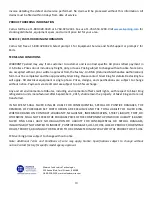
7
Cabling:
Check that cabling will not be subject to wear, corrosion, excessive pressure, vibration, sharp edges or any other adverse physical or
environmental effects. The check shall also take into account the effects of aging or continual vibration from sources such as
compressors or fans.
Detection of Flammable Refrigerants:
Under no circumstances shall potential sources of ignition be used in the searching for or detection of refrigerant leaks.
CAUTION
:
Risk of Fire or Explosion Due To Open Flame. A halide torch (or any other detector using a naked flame) shall not be used.
The following leak detection methods are deemed acceptable for all refrigerant systems:
Electronic leak detectors may be used to detect refrigerant leaks but, in the case of
FLAMMABLE REFRIGERANTS
, the sensitivity may
not be adequate, or may need re-calibration. (NOTE: Detection equipment shall be calibrated in a refrigerant-free area.) Ensure that
the detector is not a potential source of ignition and is suitable for the refrigerant used.
Leak detection equipment shall be set at a percentage of the LFL of the refrigerant and shall be calibrated to the refrigerant
employed, and the appropriate percentage of gas (25% maximum) is confirmed.
Leak detection fluids are also suitable for use with most refrigerants but the use of detergents containing chlorine shall be avoided
as the chlorine may react with the refrigerant and corrode the copper pipe-work.
Avoid the use of dish-washing soap/water as a leak-detection fluid.
NOTE Examples of leak detection fluids are:
Bubble method
Fluorescent method agents
If a leak is suspected, all naked flames shall be removed/extinguished.
If a leakage of refrigerant is found which requires brazing, all of the refrigerant shall be recovered from the system, or isolated (by
means of shut off valves) in a part of the system remote from the leak.
Removal and Evacuation:
When breaking into the refrigerant circuit to make repairs – or for any other purpose – conventional procedures shall be used.
However, for flammable refrigerants it is important that best practices be followed since flammability is a consideration. The
following procedure shall be adhered to:
a) Safely remove refrigerant following local and national regulations
b) Purge the circuit with inert gas
c) Evacuate (optional for A2L)
d) Purge with inert gas (optional for A2L)
e) Open the circuit by cutting or brazing
!
The refrigerant charge shall be recovered into the correct recovery cylinders if venting is not allowed by local and national codes. For
appliances containing flammable refrigerants, the system shall be purged with oxygen-free nitrogen to render the appliance safe for
flammable refrigerants. This process might need to be repeated several times. Compressed air or oxygen shall not be used for
purging refrigerant systems.
For appliances containing flammable refrigerants, refrigerants purging shall be achieved by breaking the vacuum in the system with
oxygen-free nitrogen and continuing to fill until the working pressure is achieved, then venting to atmosphere, and finally pulling
down to a vacuum (optional for A2L). This process shall be repeated until no refrigerant is within the system (optional for A2L).
When the final oxygen-free nitrogen charge is used, the system shall be vented down to atmospheric pressure to enable work to
take place.
Ensure that the outlet for the vacuum pump is not close to any potential ignition sources and that ventilation is available.




























